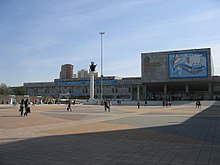Russian University of Friendship of Peoples
| Российский университет дружбы народов РУДН RUDN University |
|
|---|---|

|
|
| founding | 5th February 1960 |
| place | Moscow |
| Rector | Filippov Vladimir Mikhaylovich |
| Networks | IAU |
| Website |
www.provuz.ru (Russian) eng.rudn.ru (English) |
The Russian University of Friendship of Peoples ( Russian Российский университет дружбы народов, РУДН ) is a university in southwest Moscow .
The university in the Soviet Union
The university was founded in 1960 as the University of Friendship of Nations . In February 1961 she was given the name Patrice Lumumba after the murdered first Prime Minister of the Democratic Republic of the Congo , which she kept until 1992. Until the collapse of the Soviet Union in 1991, students mainly from Asia, Africa and Latin America could apply for the study places associated with full scholarships. In the first year 1960 there were 600 places available at the following faculties:
- Mechanical engineering, mining, general construction
- Agriculture and zoo technology
- Practical medicine and pharmacy
- Physics, mathematics, chemistry and biology
- History and philology
- Economics, Economic Planning and International Law
The university was founded in 1960 in the context of a cultural diplomatic campaign by the Soviet Union that began in the mid-1950s. Dozens of new states had emerged in the process of decolonization . The USSR tried to exploit and consolidate their anti-Western stance during the Cold War . A very pragmatic approach was maintained with the ideologically mostly completely different regimes; the elites of the countries concerned should at least be motivated to a benevolent neutrality through their training in Moscow. Some historians see the university's most important function in its symbolism as a bond between the Soviet Union and the " Third World " that has been created by decolonization .
In contrast to the practice at ordinary Soviet universities, Lumumba University students did not have to go through ideological classes. The otherwise compulsory core subjects of Marxism-Leninism , the history of the CPSU as well as political economy and philosophy, were officially missing from the curriculum. Course content that was in the interests of the countries of origin was emphasized. Students should return to their home countries with a positive image of their hostess.
The students were made up of around 13 percent female and 87 percent female students. The proportion of Soviet students who were admitted to the Lumumba University in Moscow for better socialization of foreigners fluctuated between about 10 and 30 percent, but increased steadily over time. The separation of the foreign students from non-aligned countries from the students from communist countries at the ordinary universities brought the accusation of Lumumba University to be an "apartheid university" that deliberately tried to minimize the contacts between the two groups.
The university's role as the most important point of contact for visitors from the "Third World" is reflected in the international speakers who were guests: the Chilean poet Pablo Neruda , the American singer and actor Paul Robeson , the Indian President Sarvepalli Radhakrishnan , the Prime Minister of Sri Lanka Sirimavo Bandaranaike , the Cuban President Osvaldo Dorticós and many more.
The university after 1991
The university was given its current name in 1992, and the majority of students today come from the Russian Federation . On November 24, 2003, at least 42 students from the People's Republic of China , Bangladesh , Vietnam and several African countries died in a major fire in a dormitory . Although there is some evidence of a racially motivated arson, no police investigation has been initiated.
Well-known students
- Ilich Ramírez Sánchez called Carlos , a terrorist
- Daniel Ortega
- Hifikepunye Pohamba
- Henry Ruiz
- Mahmoud Abbas
Partner universities
See also
Web links
- Website of the University of International Friendship (Russian)
- Website of the University of Friendship of Nations (English)
Individual evidence
- ↑ a b History. In: eng.rudn.ru. RUDN University, accessed August 15, 2019 .
- ^ Rector's Page. In: eng.rudn.ru. RUDN University, accessed August 15, 2019 .
- ^ List of IAU Members. In: iau-aiu.net. International Association of Universities, accessed August 15, 2019 .
- ↑ Rossen Djagalov, Christine Evans: Moscow 1960: How one imagined a Soviet friendship with the Third World , in: Andreas Hilger: The Soviet Union and the Third World. USSR, State Socialism and Anti-Colonialism in the Cold War 1945-1991, pp. 83-105.
- ↑ Tobias Rupprecht: Stranded flagship. The University of Friendship of Nations in Moscow, in: Osteuropa 1 (2010), pp. 95–114
- ↑ Rossen Djagalov, Christine Evans: Moscow 1960: How one imagined a Soviet friendship with the Third World , in: Andreas Hilger: The Soviet Union and the Third World. USSR, State Socialism and Anti-Colonialism in the Cold War 1945-1991 , p. 100.
- ↑ Rossen Djagalov, Christine Evans: Moscow 1960: How one imagined a Soviet friendship with the Third World , in: Andreas Hilger: The Soviet Union and the Third World. USSR, State Socialism and Anti-Colonialism in the Cold War 1945-1991 , p. 88.
- ↑ Egyptian Russian University : Patron Universities & Partners (English)
Coordinates: 55 ° 39 ′ 3.4 " N , 37 ° 30 ′ 16.5" E
